Introduction
ObservableLists (and ObservableSets, and ObservableMaps, for that matter), are designed to invalidate and trigger Listeners when items are add or removed from them. Screen elements like ListView, TableView and the pop-ups in ComboBox will automatically update when the ObservableLists that back them are updated.
But what about those cases where your ObservableLists are made of up composed objects? Is it possible to detect that an ObservableList has changed when one of the fields inside an item has changed?
That’s what “extractors” are for. They allow you to detect changes to Property fields inside the items in your list, and to trigger Listeners on the ObservableList as a result.
The Basics
The JavaDocs for extractors is pretty thin.
The first thing that you’ll notice if you check out the entry for ObservableList is that there are no constructors for ObservableList because it’s an Interface. None of the “All Known Implementing Classes” section look promising either.
Typically, you’ll get an ObservableList because it’s already part of a Node class like ListView, TableView or ComboBox. But if you want to create one yourself, you’ll need to use the static library class, FXCollections.
If you go to the JavaDocs for FXCollections you’ll see that there are lots and lots of ways to create different kinds of ObservableLists, some of which specify extractors. Let’s look at the details for observableArrayList(Callback<E,Observable[]> extractor):
public static <E> ObservableList<E> observableArrayList(Callback<E,Observable[]> extractor)
Creates a new empty ObservableList that is backed by an array list and listens to changes in observables of its items.
The extractor returns observables (usually properties) of the objects in the created list. These observables are listened for changes and the user is notified of these through an update change of an attached ListChangeListener. These changes are unrelated to the changes made to the observable list itself using methods such as add and remove.
For example, a list of Shapes can listen to changes in the shapes’ fill property.
This seems to hint at something interesting, but it doesn’t really explain much, does it?
Let’s take a closer look at the constructor parameter: Callback<E,Observable[]> extractor.
A Callback is just a Function, meaning that it accepts one value and then returns another. The name “Callback” implies that it is going to be used somewhere deep down in the internals of something. Somewhere that we can’t see, and probably don’t want to see. The Callback is a “hook” to allow that hidden code to get at something that we, the application programmers, define.
In this case, the Callback accepts something of type E. What is E? Well, ObservableList itself is generic, and E in this case refers to the type of elements that comprise our ObservableList. This means that the Callback is just going to accept a single element of our ObservableList, whatever that happens to be.
The output from our Callback is going to be an array of Observable. Observable is the top level Interface that all of the Properties and observable classes implement. It only specifies three methods, addListener(), removeListener() and subscribe(). That last one, subscribe() is new, and ObservableList extractors pre-dates it. So we don’t need to worry about it here.
What this tells us is that at some point, deep inside the ObservableList code, JavaFX is going to add a Listener to every Observable that we return for every item in our ObservableList.
The only question left is: What does that Listener do?
What Does the Extractor Do?
In my article about ObservableLists, part of my series on Observables, I wrote some code to see what kind of Listeners are activated when changes are made to ObservableLists. This involved adding, deleting, replacing and swapping ObservableList elements.
We can use some of that same code here, to see how extractors translate to the Listeners triggered the ObservableList.

While code is this article is written in Kotlin, all of the JavaFX concepts are exactly the same. Most of the Kotlin should be intuitively obvious to Java programmers, but if you need help understanding it, refer to this page.
To start, we’ll look at the code without an extractor, and see what it does…
private val obList: ObservableList<ExampleData> = FXCollections.observableArrayList()
private val messages: StringProperty = SimpleStringProperty("")
private val totBinding = object : IntegerBinding() {
init {
super.bind(obList)
}
override fun computeValue(): Int = obList.map { it.value2.value }.sum()
}
override fun start(stage: Stage) {
obList.subscribe { messages.value += "Invalidated \n" }
for (x in 1..5) obList.add(ExampleData(x))
messages.value += "Data Loaded\n"
messages.value += obList.map { it.value2.value }.joinToString() + "\n"
stage.scene = Scene(createContent()).apply { }
stage.show()
}
private fun createContent(): Region = BorderPane().apply {
top = HBox(
10.0,
Label().apply { textProperty().bind(totBinding.asString()) },
Label().apply { textProperty().bind(obList[2].value2.asString()) })
center = TextArea().apply {
textProperty().bind(messages)
}
bottom = Button("Increment Item").apply {
setOnAction {
messages.value += "Button Clicked\n"
with(obList[2]) { value2.value = value2.value + 1 }
messages.value += obList.map { it.value2.value }.joinToString() + "\n"
}
}
padding = Insets(20.0)
}
}
class ExampleData(initialValue: Int) {
val value1: IntegerProperty = SimpleIntegerProperty(initialValue)
val value2: IntegerProperty = SimpleIntegerProperty(initialValue)
}
fun main() = Application.launch(ExtractorExample1::class.java)
We have an ObservableList of DataExample, which is just an object with two IntegerProperties in it. We populate it with 5 items, where both IntegerProperties are populated with the same value and that value increments for each item that we add.
The GUI is a BorderPane with an HBox at the top with two Labels. One shows the total of all of DataExample.value2 in the ObservableList through a Binding and the other has the current value of obList[2].value2.
The centre is a TextArea which is bound to a StringProperty called messages. Various bits of code add new data to messages, and we’ll look at this.
At the bottom is a Button. When this Button is clicked three things happen:
- “Button Clicked” is added to
messages. obList[2].value2is incremented.- A list of all of the values in
value2is added tomessages
We also have an InvalidationListener (through subscribe()) on obList that just adds “Invalidated” to messages. And we add “Data Loaded” to messages when all of the setup is done.
And all of this looks like this:
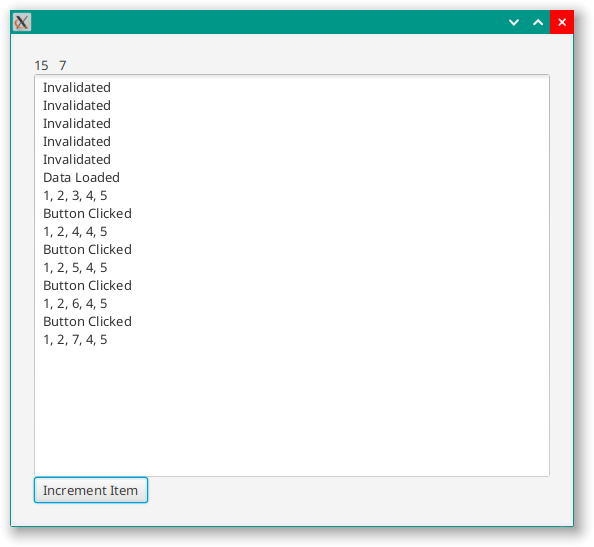
You can see that obList invalidates every time a new ExampleData is added to it. Then the “Data Loaded” message is appended and we see the initial list of values in value2.
Then we see that the Button was clicked, and that obList[2].value2 was incremented. And then again, and again, and again.
We can also see that our Label bound to obList[2].value2 has been updated, and it shows “7” - just as you would expect.
However, the other Label hasn’t been updated. This is the one bound to the ObservableList itself. Also, out InvalidationListener never fired again.

When ObservableList items are composed objects containing Observable type fields, changes to those internal fields will not trigger Listeners on the ObservableList.
Adding an Extractor
All we are going to do is change a single line of the code from above. This:
private val obList: ObservableList<ExampleData> = FXCollections.observableArrayList()
will change to this:
private val obList: ObservableList<ExampleData> =
FXCollections.observableArrayList({ item -> arrayOf(item.value2) })
In this code, { item -> arrayOf(item.value2) } is the Callback for the extractor. It creates an array, and it includes ExampleData.value2 in that array.
Now, when we run the program and click the Button four times, we get this:
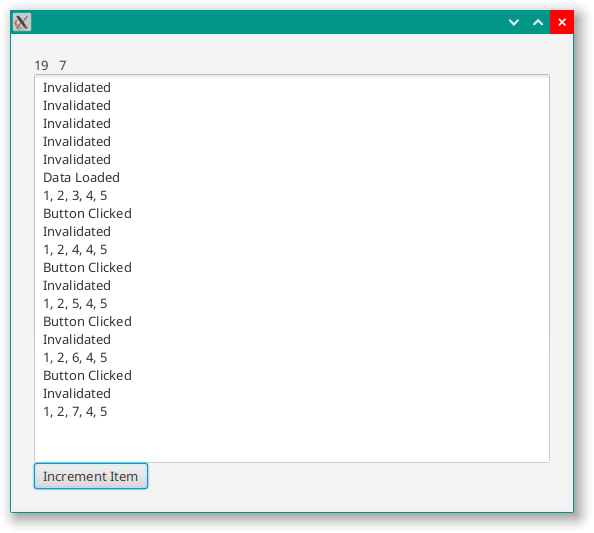
The first thing that you notice is that we get the “Invalidated” message right after every “Button Clicked” message. This means that the InvalidationListener on obList has fired!
The other thing that you should notice is that the first Label now says “19”, which is 1+2+7+4+5. This means that the Binding on obList that sums up the values is now working!

When an ObservableList has an extractor that returns an encapsulated Observable field of the List items, then changes to that internal fields will trigger Listeners on the ObservableList.
This tells us that, at a minumum, the InvalidationListener that the ObservableList puts on every value2 of every ExampleData in the list is used to trigger an InvalidationListener on the ObservableList itself. That’s enough to trigger the Binding on the ObservableList, too.
But does it do more?
Will a ListChangeListener Work?
Let’s change the code a little bit to add a ListChangeListener to obList to see if the extractor will cause it to fire:
override fun start(stage: Stage) {
obList.subscribe { messages.value += "Invalidated \n" }
obList.addListener(ListChangeListener { change ->
while (change.next()) {
if (change.wasPermutated()) {
messages.value += "List was permutated\n"
} else {
if (change.wasRemoved()) {
messages.value += "List item was removed\n"
}
if (change.wasAdded()) {
messages.value += "List item was added\n"
}
if (change.wasUpdated()) {
messages.value += "List item ${change.from} was updated\n"
}
}
}
})
for (x in 1..5) obList.add(ExampleData(x))
messages.value += "Data Loaded\n"
messages.value += obList.map { it.value2.value }.joinToString() + "\n"
stage.scene = Scene(createContent()).apply { }
stage.show()
}
ListChangeListener accepts a value of ListChangeListener.Change, which itself is an iterable construct and may contain several different changes to the ObservableList that happened at the same time. These changes can be that an item (or range of items) were removed, added or permutated (which means they were replaced). We need code that will look at all of the types of changes to see what is happening.
Again, we’ll run the code and click on the Button a few times:
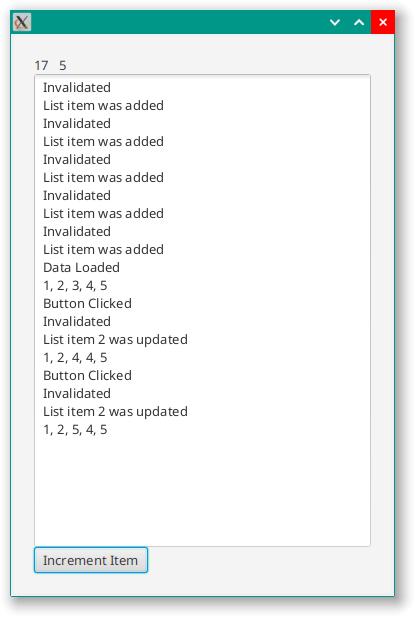
Here, we can see that the ListChangeListener fires as each item is added to the ObservableList, but then it fires with an “update” Change when the Button is clicked. It also reports which element was updated in Change.from.
From this, we can safely assume that a ListChangeListener is going to detect a change made to a field specified in an extractor.
Will a ListProperty Work?
There is another class, called ListProperty that acts as a wrapper around an ObservableList. What if we put our obList into a ListProperty and then add a ChangeListener to that ListProperty?
override fun start(stage: Stage) {
val listProperty = SimpleListProperty(obList)
listProperty.addListener(InvalidationListener { messages.value += "Invalidated \n" })
listProperty.subscribe { oldVal, newVal ->
messages.value += "Change -> Old: $oldVal New: $newVal\n"
}
for (x in 1..5) obList.add(ExampleData(x))
messages.value += "Data Loaded\n"
messages.value += obList.map { it.value2.value }.joinToString() + "\n"
stage.scene = Scene(createContent()).apply { }
stage.show()
}
Notice that I’ve also moved the InvalidationListener to the ListProperty, so that we can see if it fires on there as well.
When we run this, clicking the Button four times, we get:
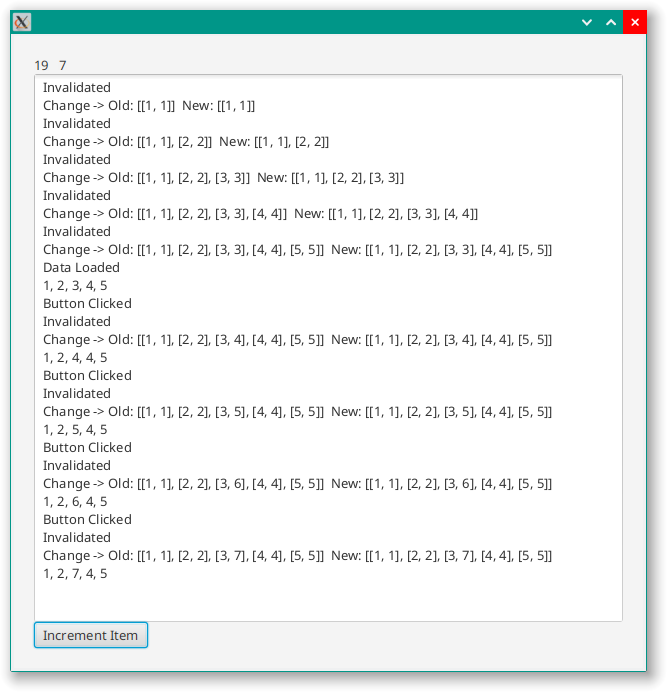
We see the ChangeListener firing as the elements are added, and this not suprising. You will notice, however, thet the oldVal and newVal are both actually the newVal. This is a quirk of ChangeListeners on ListProperty, and has nothing to do with extractors.
Then we see the ChangeListener also fires on the changes to the enclosed field through the extractor. This is interesting, although we still don’t get to see the correct value for oldVal.
You should also note that the InvalidationListener also fires every time for the ListProperty.
And just to make sure this is the extractor that is doing this, I took it out and re-ran the program:
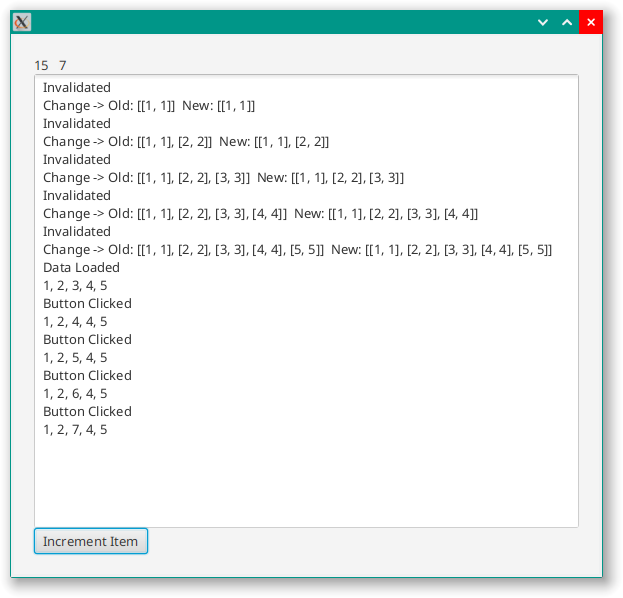
Here, we just get the Listeners firing for the additions to the ObservableList. The changes to the enclosed Property do not trigger any Listeners.
Advanced Extractors
If you look up extractor examples on-line, you’ll never see anything more than:
Callback<TestClass, Observable[]> extractor = obj -> new Observable[]{ obj.nameProperty() };
ObservableList<TestClass> list = FXCollections.observableArrayList(extractor);
I just pulled this example from a StackOverflow question, but it’s pretty much the standard.
But the extractor is a Callback and can do much more, if you want. Let’s take a look at that:
class ExtractorExample4 : Application() {
private val obList: ObservableList<ExampleData1> =
FXCollections.observableArrayList({ item -> item.extractableValues() })
private val messages: StringProperty = SimpleStringProperty("")
private val totBinding = object : IntegerBinding() {
init {
super.bind(obList)
}
override fun computeValue(): Int = obList.map { it.value2.value }.sum()
}
override fun start(stage: Stage) {
obList.addListener(InvalidationListener { messages.value += "Invalidated \n" })
for (x in 0..5) obList.add(ExampleData1(x))
messages.value += "Data Loaded\n"
messages.value += obList.map { it.value2.value }.joinToString() + "\n"
stage.scene = Scene(createContent()).apply { }
stage.show()
}
private fun createContent(): Region = BorderPane().apply {
top = HBox(
10.0,
Label().apply { textProperty().bind(totBinding.asString()) },
Label().apply { textProperty().bind(obList[2].value2.asString()) })
center = TextArea().apply {
textProperty().bind(messages)
}
bottom = HBox(
20.0, Button("Increment Item 2").apply {
setOnAction {
messages.value += "Button 1 Clicked\n"
with(obList[2]) { value2.value = value2.value + 1 }
messages.value += obList.map { it.value2.value }.joinToString() + "\n"
}
},
Button("Increment Item 5").apply {
setOnAction {
messages.value += "Button 2 Clicked\n"
with(obList[5]) { value2.value = value2.value + 1 }
messages.value += obList.map { it.value2.value }.joinToString() + "\n"
}
})
padding = Insets(20.0)
}
}
class ExampleData1(private val initialValue: Int) {
val value1: IntegerProperty = SimpleIntegerProperty(initialValue)
val value2: IntegerProperty = SimpleIntegerProperty(initialValue)
override fun toString() = "[${value1.value}, ${value2.value}]"
fun extractableValues(): Array<Observable> {
return if (initialValue < 4) arrayOf(value1) else arrayOf(value2)
}
}
fun main() = Application.launch(ExtractorExample4::class.java)
You’ll notice that we’ve added ExampleData1, which differs from ExampleData in two ways:
- The constructor parameter
initialValuehas now been changed into a private immutable field. - We’ve have a new method,
extractableValues.
This new method will return an Array containing either value1 or value2 depending on whether initialValue is less than 4 or not.
Additionally, we’ve added a second Button that works very much the same way as the original Button but acts on the 5th item in the ObservableList, which should have an initialValue greater than 4.
The Listeners have been return to very much the way that they were before we introduced the ListProperty, which has now been removed.
Here’s what the screen looks like when we click the first Button a few times:
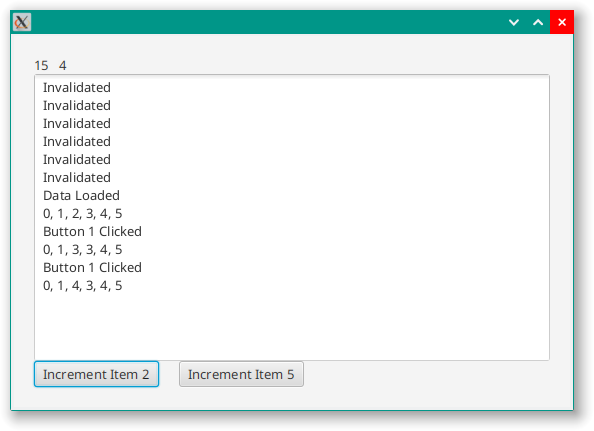
You can see the messages from the Button click, and you can see the updated values in obList. You can also see that the second Label is still correct. However, the first Label does NOT have the correct value, and we do not have any “Invalidated” messages for those clicks.
This is expected, because the initialValue of the item we clicked was “2” which is less than “4” and the extractor pulls value1 for that item, while the Button is updating value2.
Here’s what it looks like after we click the new Button a few times:
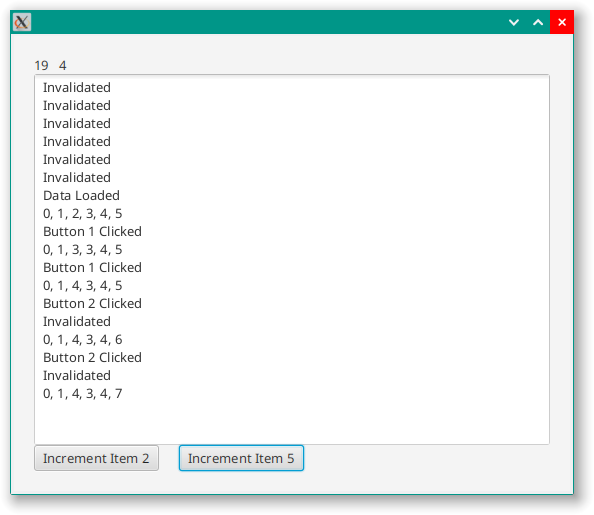
Now we see the “Invalidated” messages, and the first Label now contains the correct total.
Uses of This Technique
I’ve never seen anyone demonstrate anything like this before, and I’m not sure how often a use would pop up for this in real life. But there are couple of things to take note of:
The Extraction Details are Encapsulated
When you think about it, you see that this approach puts the logic for extraction inside the ObservableList items. This means that the nature of the extraction is hidden from the ObservableList itself.
If you are using a framework with a formal Presentation Model, like MVCI, then you are most likely going to instantiate your ObservableLists inside the Model. Defining the extractors as part of that call to FXCollections.observableArrayList() requires that the Model knows about the structure of the objects that are put inside the ObservableList.
This might not be appropriate, even though those ObservableList items are part of the Presentation Model.
Still, it’s worth considering, and I can see some value in putting the logic that dictates how the items will behave in an ObservableList right beside the actual data that comprises the items.
The Extraction Logic Needs to Be Immutable
You’ll notice that I very deliberately based the extraction logic on a field defined as val instead of var. This is the same as using final in Java.
This is because the extractor logic is only run once, when the item is added to the ObservableList.
I checked the source code and found that the extractor code is run to get an Array of Observable and then the ObservableList loops through all of these Observables and adds an InvalidationListener to each one. This code is run when the ObservableList is created as a wrapper around an existing List, like this:
val obList = FXCollections.observableArrayList(existingList, extractor)
In this case, the interal code will loop through every item in existingList, run the extractor against them and the add the InvalidationListeners to every Observable returned by the extractor for each item.
The extractor code is also run when a new item is added to an existing ObservableList that has an extractor.
There extractor code is also run when an item is removed from an ObservableList, in order to remove the InvalidationListeners that were added by the ObservableList.
Other than that, the extract isn’t ever run against an item.
If, in our example, we had made initialValue a var, and provided some way to change it after the items were in the list, there would be no change to InvalidationListeners added by the ObservableList, because they were already established. So, you could end up with a system where the apparent behaviour of the extractor doesn’t match the current state of the data.
The worse case scenario is that if the item is removed from the ObservableList, then some of the InvalidationListeners might not be removed because the extractor behaviour wasn’t the same as when the item was added to the ObservableList. That could give some weird results.
Extractors in TableView Items
Probably the most common use of composed Property objects as items in ObservableLists is in TableView. So let’s take a look at how TableView columns are usually set up, and how they interact with enclosed Property fields.
Here’s the same example code, with just a TableView added:
class ExtractorExample5 : Application() {
private val obList: ObservableList<ExampleData> =
FXCollections.observableArrayList()
private val messages: StringProperty = SimpleStringProperty("")
private val totBinding = object : IntegerBinding() {
init {
super.bind(obList)
}
override fun computeValue(): Int = obList.map { it.value2.value }.sum()
}
override fun start(stage: Stage) {
obList.addListener(InvalidationListener { messages.value += "Invalidated \n" })
for (x in 0..5) obList.add(ExampleData(x))
messages.value += "Data Loaded\n"
messages.value += obList.map { it.value2.value }.joinToString() + "\n"
stage.scene = Scene(createContent()).apply { }
stage.show()
}
private fun createContent(): Region = BorderPane().apply {
top = HBox(
10.0,
Label().apply { textProperty().bind(totBinding.asString()) },
Label().apply { textProperty().bind(obList[2].value2.asString()) })
center = TextArea().apply {
textProperty().bind(messages)
}
left = TableView<ExampleData>().apply {
items = obList
columns += TableColumn<ExampleData, Int>("Value 1").apply {
setCellValueFactory { p -> p.value.value1.asObject() }
}
columns += TableColumn<ExampleData, Int>("Value 2").apply {
maxHeight = 100.0
setCellValueFactory { p -> p.value.value2.asObject() }
setCellFactory { column ->
object : TableCell<ExampleData, Int>() {
override fun updateItem(newItem: Int?, empty: Boolean) {
super.updateItem(newItem, empty)
messages.value += "Table Cell Update: $newItem\n"
text = null
graphic = null
newItem?.let {
if (!empty) {
text = newItem.toString()
}
}
}
}
}
}
}
bottom = Button("Increment Item 2").apply {
setOnAction {
messages.value += "Button 1 Clicked\n"
with(obList[2]) { value2.value = value2.value + 1 }
messages.value += obList.map { it.value2.value }.joinToString() + "\n"
}
}
padding = Insets(20.0)
}
}
fun main() = Application.launch(ExtractorExample5::class.java)
This is very close to the first example, but with the TableView added. I’ve also removed the extractor from the ObservableList, so what we will see is pure TableView behaviour.
I added a custom TableCell to the second column so that we could see when the updateItem() method gets called, and what value it receives. I’ve also limited the height of the TableView to restrict the number of TableCells instantiated because they generate a lot of messages, even if empty:
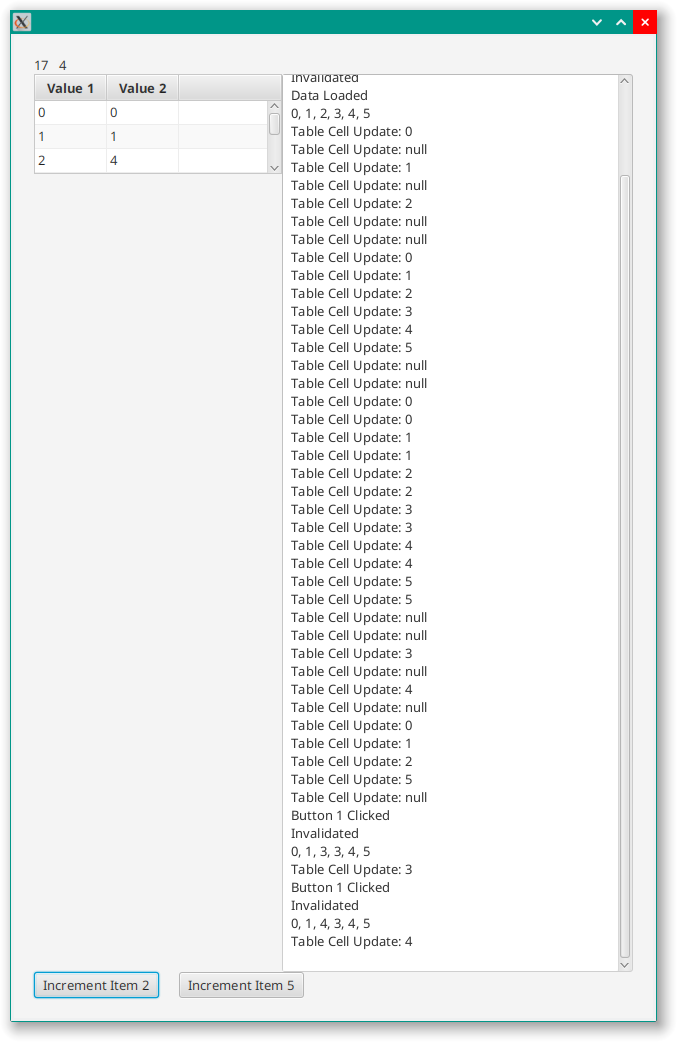
The Button has been clicked twice, and you can see from the TableView that it has updated correctly. You can see from the messages, that the TableCells get updated a lot just setting things up. If you look at the bottom of the messages you can see the two Button clicks, and you can see the TableCell updating right away. You do not see any invalidation messages from the ObservableList, however.
This tells us that the TableView puts a Listener of some sort on the Property when it identifies it by calling the setCellValueFactory. That’s the only way that this will work.
What happens if we put the extractor back into the ObservableList? You get this:
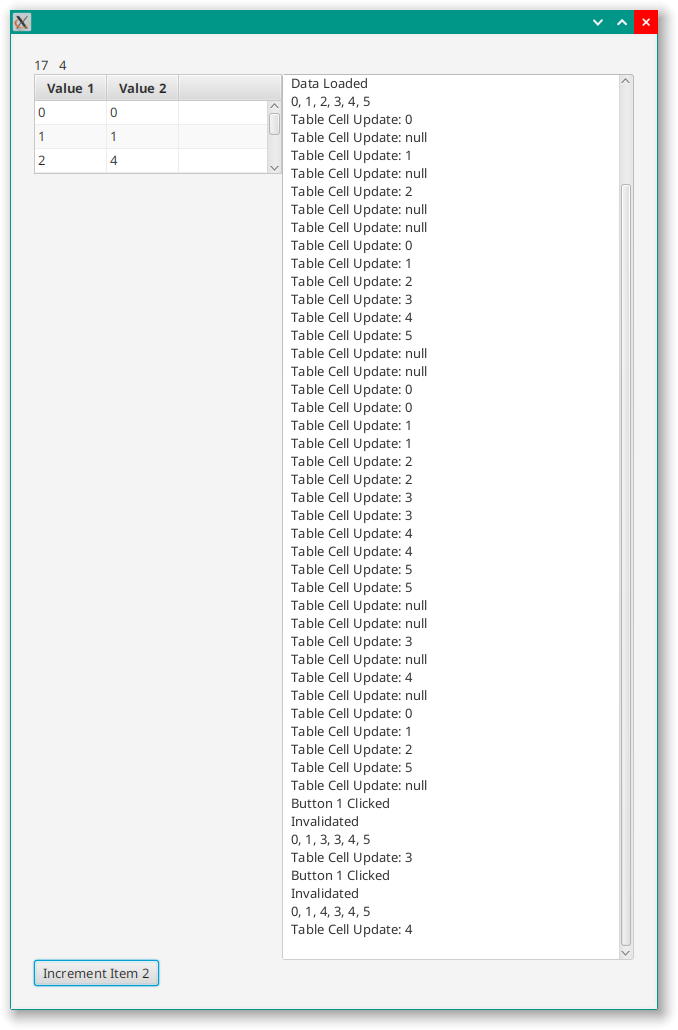
Not much, really.
The first Label now has the correct total, as expected, and we see that the ObservableList invalidates after each Button click. But it doesn’t cause the TableCell to update twice, or anything like that.
We can determine from this that adding an extractor to an ObservableList used in a TableView doesn’t hurt the performance of the TableView, but it doesn’t help it either.
Of course this is only true if you compose your TableView items from Properties and other ObservableValues.
Extractors in ListView Items
So now we know that TableView works fine without extractors, but what about ListView?
We’ll go back to our example, and change the layout so that it shows a ListView instead of a TableView:
private fun createContent(): Region = BorderPane().apply {
top = HBox(
10.0,
Label().apply { textProperty().bind(totBinding.asString()) },
Label().apply { textProperty().bind(obList[2].value2.asString()) })
center = TextArea().apply {
textProperty().bind(messages)
}
left = ListView<ExampleData>().apply {
items = obList
cellFactory = Callback { _ ->
object : ListCell<ExampleData>() {
val label1 = Label()
val label2 = Label()
val layout = VBox(2.0).apply {
children += HBox(10.0, Label("Value 1:"), label1)
children += HBox(10.0, Label("Value 2:"), label2)
padding = Insets(8.0)
}
override fun updateItem(newItem: ExampleData?, isEmpty: Boolean) {
super.updateItem(newItem, isEmpty)
graphic = null
text = null
newItem?.let {
if (!isEmpty) {
label1.text = newItem.value1.value.toString()
label2.text = newItem.value2.value.toString()
graphic = layout
}
}
}
}
}
}
bottom = Button("Increment Item 2").apply {
setOnAction {
messages.value += "Button 1 Clicked\n"
with(obList[2]) { value1.value = value1.value + 1 }
messages.value += obList.map { it.value1.value }.joinToString() + "\n"
}
}
padding = Insets(20.0)
}
Here we have a custom ListCell layout that contains a VBox holding two HBoxes. Each HBox has two Labels, one is just a title, and the other is loaded with either ExampleData.value1.value or ExampleData.value2.value. No Bindings are used, so there’s no reliance inside the ListCell on the Property nature of value1 or value2.
The updateItem() method does the usual stuff, and loads value1 and value2 into their respective Labels.
The only other change to this code from the TableView version was to change the Button action to update ExampleData.value1 instead of ExampleData.value2. The ObservableList still has an extractor that returns value2, so this change essentially disables the extractor for this example.
This is what it looks like when it is run and the Button is clicked a few times:
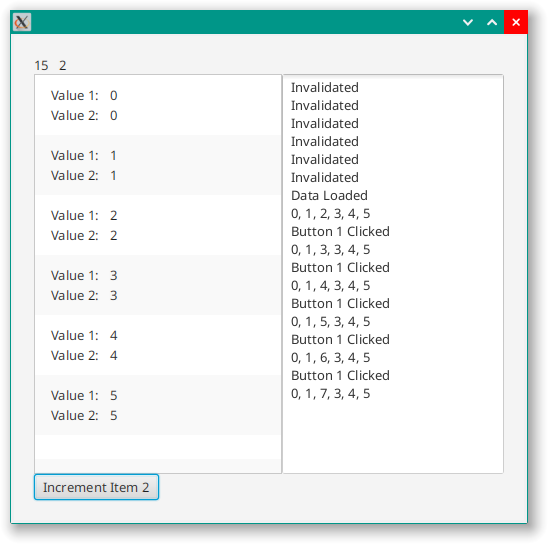
You can see that the values displayed in the ListView do not change at all. You can see in the TextArea that the Button has been clicked several times, yet the ObservableList never invalidated, but that value1 did increment each time.
If we change the extractor to return value1 instead of value2, this is what it looks like:

Now you can see that the ListView values are correct, and that the Button click causes the ObservableList to invalidate.
Is This a Good Approach?
This approach has the advantage that you can implement a very naive design for the ListCell, without having to worry about binding and unbinding from a changing itemProperty(). This is pretty much exactly the same approach to ListCell design that you’ll see as the copypasta example in virtually every online tutorial about ListView. It’s simple, and it’s easy, and it’s what everybody knows.
However, it effectively splits the logic involved in keeping the ListCell up to date between two places, the ListCell itself, and the extractor.

Always ask yourself this question: "How much code will a maintenance programmer need to look at to fix a bug with this feature?"
In this case, you cannot really understand how the ListCell works without looking at the instantiation of ObservableList to see that it has an extractor. That’s very likely to be in another class altogether.
Some time back, before JavaFX 19, achieving this entirely within the ListCell would have been a bit tedious. The Labels would need to be bound to fields inside a value that itself was changing. This would have required unbinding and the rebinding the Labels each time the value in the ListCell was changed.
But JavaFX 19 introduced ObservableValue.flatmap(), and now we can skip all the unbinding and rebinding.
Here’s the ListCell implemented that way:
cellFactory = Callback { _ ->
object : ListCell<ExampleData>() {
val label1 = Label().apply {
textProperty().bind(itemProperty().flatMap { item -> item.value1.asString() })
}
val label2 = Label().apply {
textProperty().bind(itemProperty().flatMap { item -> item.value2.asString() })
}
val layout = VBox(2.0).apply {
children += HBox(10.0, Label("Value 1:"), label1)
children += HBox(10.0, Label("Value 2:"), label2)
padding = Insets(8.0)
}
init {
graphicProperty().bind(
Bindings.createObjectBinding<Region>(
{ if (item != null) layout else null },
itemProperty()
)
)
}
}
}
The Labels are bound to fields in itemProperty() through flatMap(). Now, if the value in the field changes, or the itemProperty() itself changes, the binding will handle it automatically. By also creating a Binding to control whether or not the graphic displays in the init{} block, we can now do away with updateItem() entirely. Everything is simply dependent on itemProperty().
In order to test this, I removed the extractor from the ObservableList. The result looks like this:
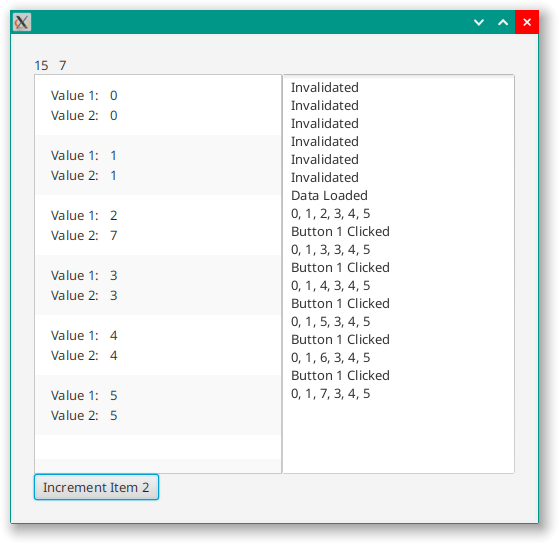
You can see that the items in the ListView are still correct, and the messages show the Button clicks that do not trigger an “Invalidated” message from the Listener.
Obviously, this requires a somewhat deeper understanding of the ListCell mechanics. Most beginners aren’t even aware that item exists in the ListCell as on ObjectProperty, and they assume that the only way to deal with a changing item is through updateItem().
What About Performance?
You may be thinking, “What if I have an ObservableList with thousands, and thousands of items? Won’t that mean thousands and thousands of Listeners running all the time?”
For sure, there is some overhead to Listeners, but it’s not as much as you might think. Let’s look at what happens when you add an InvalidationListener to an Observable…
To find this you need to look at ObjectPropertyBase which is the highest abstract class that implements addListener() for Properties. In it, you’ll find that it delegates to something called ExpressionHelper which is an instance variable of ObjectPropertyBase, and then that ends up in a subclass of ExpressionHelper called Generic. In there, you will find this:
protected Generic<T> addListener(InvalidationListener listener) {
if (invalidationListeners == null) {
invalidationListeners = new InvalidationListener[] {listener};
invalidationSize = 1;
} else {
final int oldCapacity = invalidationListeners.length;
if (locked) {
final int newCapacity = (invalidationSize < oldCapacity)? oldCapacity : (oldCapacity * 3)/2 + 1;
invalidationListeners = Arrays.copyOf(invalidationListeners, newCapacity);
} else if (invalidationSize == oldCapacity) {
invalidationSize = trim(invalidationSize, invalidationListeners);
if (invalidationSize == oldCapacity) {
final int newCapacity = (oldCapacity * 3)/2 + 1;
invalidationListeners = Arrays.copyOf(invalidationListeners, newCapacity);
}
}
invalidationListeners[invalidationSize++] = listener;
}
return this;
}
Yikes!
In summary, it has an array of InvalidationListeners and it adds your new InvalidationListener to it. The remaining dozen or so lines of appear to be some kind of memory management optimization. That’s good to see, if you are worried about performance degredation associated with extractors.
So, this means that every Observable potentially contains an Array that holds all of the InvalidationListeners that have been added to it.
How does it use this?
In ObjectPropertyBase we have this:
public void set(T newValue) {
if (isBound()) {
throw new java.lang.RuntimeException((getBean() != null && getName() != null ?
getBean().getClass().getSimpleName() + "." + getName() + " : ": "") + "A bound value cannot be set.");
}
if (value != newValue) {
value = newValue;
markInvalid();
}
}
The most important part for us is the call to markInvalid():
protected void fireValueChangedEvent() {
ExpressionHelper.fireValueChangedEvent(helper);
}
private void markInvalid() {
if (valid) {
valid = false;
invalidated();
fireValueChangedEvent();
}
}
And we are back to ExpressionHelper again, and then back into Generic for the actual implementation:
for (int i = 0; i < curInvalidationSize; i++) {
try {
curInvalidationList[i].invalidated(observable);
} catch (Exception e) {
Thread.currentThread().getUncaughtExceptionHandler().uncaughtException(Thread.currentThread(), e);
}
}
This is just a snippet of the code for this method, but you can see how it works. It loops through the Array of InvalidationListeners and invokes invalidated() on each one. Remember that InvalidationListener is a Functional Interface with one method, invalidated().
If you were picturing an implementation where JavaFX had some master list of Listeners and it had to check them all every time something changed, then you can see that this is backwards to that. Each Observable maintains its own list of Listeners that have been registered with it. Then when its value is updated, it triggers each of those InvalidationListeners.
If there is a potential performance hit, it would be from having many Listeners on each Observable item. Not from having many Observable items with one or two Listeners each.
Conclusion
Creating an ObservableList with an extractor causes just two things to happen:
- The
ObservableListwill invalidate, and fire anyInvalidationListenerson it when anyObservablereturned from the extractor invalidates. - If you wrap the
ObservableListin aListPropertythatListPropertywill both invalidate and fire andChangeListenerson it when anyObservablereturn from the extractor invalidates.
Invalidation is the key concept on Bindings. This is because Bindings always recalculate by calling their computeValue() method when any of their dependencies invalidates.
This means that you can create Bindings on ObservableLists that will re-evaluate not just when items in the ObservableList are added, removed or replaced, but when internal values in those ObservableList items change…if you add the appropriate extractor.